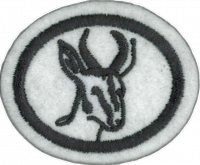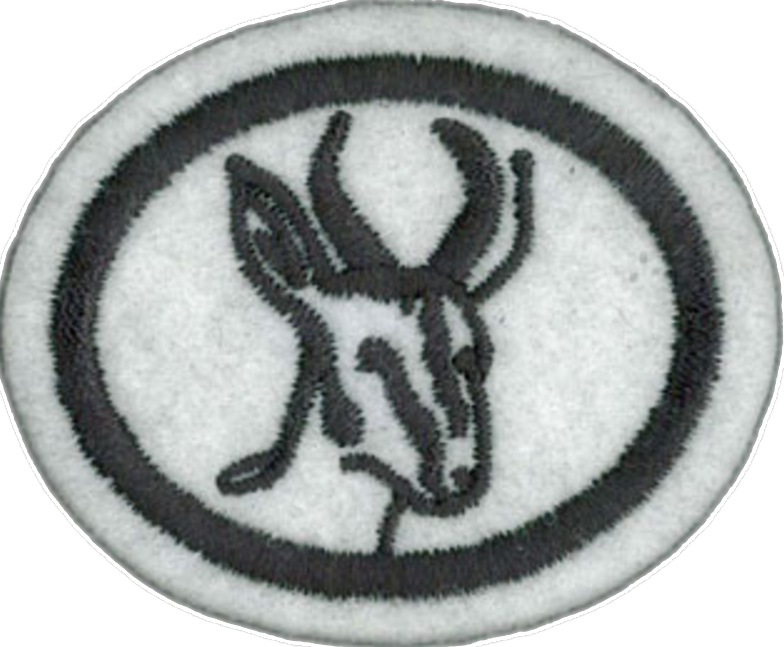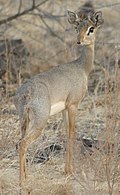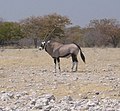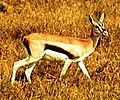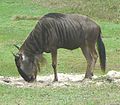Difference between revisions of "AY Honors/Antelopes/Answer Key/es"
(Created page with "Especialidades JA/Antílopes/Respuestas") |
(Created page with "<noinclude>") |
||
| Line 10: | Line 10: | ||
{{CloseReq}} <!-- 1 --> | {{CloseReq}} <!-- 1 --> | ||
{{ansreq|page={{#titleparts:{{PAGENAME}}|2|1}}|num=2}} | {{ansreq|page={{#titleparts:{{PAGENAME}}|2|1}}|num=2}} | ||
| − | <noinclude> | + | <noinclude></noinclude> |
| − | </noinclude> | + | <!-- 2. Decir tres grupos de tamaño de estos animales, con dos ejemplos de cada uno. --> |
| − | <!-- 2. | + | Pequeños Antílopes: Duiker, klipspringer y dik-dik |
| − | + | Antílopes Medianos: Bushbuck, impala y springbok | |
| − | + | Antílopes Grandes: Ñúes y elands | |
| − | |||
| − | |||
| − | + | <noinclude></noinclude> | |
| − | <noinclude | ||
| − | |||
{{CloseReq}} <!-- 2 --> | {{CloseReq}} <!-- 2 --> | ||
{{ansreq|page={{#titleparts:{{PAGENAME}}|2|1}}|num=3}} | {{ansreq|page={{#titleparts:{{PAGENAME}}|2|1}}|num=3}} | ||
| − | <noinclude> | + | <noinclude></noinclude> |
| − | </noinclude> | + | <!-- 3. Ser capaz de identificar por lo menos 15 diferentes antílopes. --> |
| − | <!-- 3. | ||
<gallery> | <gallery> | ||
Image:Haeckel Antilopina Addax nasomaculatus.jpg|Addax | Image:Haeckel Antilopina Addax nasomaculatus.jpg|Addax | ||
Image:Bongoza.jpg|Bongo | Image:Bongoza.jpg|Bongo | ||
Image:BontebokP1.jpg|Bontebok | Image:BontebokP1.jpg|Bontebok | ||
| − | Image:Dik-dik.jpg| | + | Image:Dik-dik.jpg|Dic-dic |
| − | Image:Zwergantilope-drawing.jpg|Duiker | + | Image:Zwergantilope-drawing.jpg|Duiker (cefalofo) |
Image:Taurotragus_oryx_(captive).jpg|Eland | Image:Taurotragus_oryx_(captive).jpg|Eland | ||
| − | Image:Oryx gazella 1.jpg|Gemsbok | + | Image:Oryx gazella 1.jpg|Gemsbok (órice del Cabo) |
| − | Image:Hardebeest.jpg| | + | Image:Hardebeest.jpg|Alcélafo |
Image:Impala.JPG|Impala | Image:Impala.JPG|Impala | ||
| − | Image:Klippspringer-drawing.jpg| | + | Image:Klippspringer-drawing.jpg|Saltarrocas |
| − | Image:Tragelaphus angasii Nyala female 1.jpg| | + | Image:Tragelaphus angasii Nyala female 1.jpg|Niala |
| − | Image:Ourebia ourebi cropped.jpg| | + | Image:Ourebia ourebi cropped.jpg|Oribí |
| − | Image:Lightmatter Zambian Sable Antelope.jpg| | + | Image:Lightmatter Zambian Sable Antelope.jpg|Antílope sable o negro |
| − | Image:Springbok.JPG|Springbok | + | Image:Springbok.JPG|Springbok (gacela saltarina) |
| − | Image:Thompson's Gazelle.jpeg| | + | Image:Thompson's Gazelle.jpeg|Gacela de Thomson |
| − | Image:Wildebeest cropped.jpg| | + | Image:Wildebeest cropped.jpg|Ñu |
</gallery> | </gallery> | ||
| − | |||
| − | + | <noinclude></noinclude> | |
| − | <noinclude | ||
| − | |||
{{CloseReq}} <!-- 3 --> | {{CloseReq}} <!-- 3 --> | ||
{{ansreq|page={{#titleparts:{{PAGENAME}}|2|1}}|num=4}} | {{ansreq|page={{#titleparts:{{PAGENAME}}|2|1}}|num=4}} | ||
| − | <noinclude> | + | <noinclude></noinclude> |
| − | </noinclude> | + | <!-- 4. ¿Qué comen? ¿Cómo digieren sus alimentos? --> |
| − | <!-- 4. | + | Los antílopes son rumiantes. Al igual que otros rumiantes, como el ganado vacuno y las ovejas, tienen los dientes de las mejillas o molares bien desarrollados, que muelen el barro en una pulpa. No tienen incisivos superiores; para rasgar los tallos y hojas de la hierba, sus incisivos inferiores presionan contra una almohadilla de goma superior dura cuando muerden. |
| − | |||
| − | |||
| − | + | <noinclude></noinclude> | |
| − | <noinclude | ||
| − | |||
{{CloseReq}} <!-- 4 --> | {{CloseReq}} <!-- 4 --> | ||
{{ansreq|page={{#titleparts:{{PAGENAME}}|2|1}}|num=5}} | {{ansreq|page={{#titleparts:{{PAGENAME}}|2|1}}|num=5}} | ||
Revision as of 08:58, 4 April 2021
1
Los antílopes son un grupo de animales herbívoros africanos y asiáticos, que se distinguen por un par de cuernos huecos en la cabeza. Muchos están más estrechamente relacionados con las vacas o las cabras que entre sí. Hay muchas especies diferentes de antílopes, que varían en tamaño desde el pequeño antílope real hasta el Eland gigante. Por lo general, tienen una figura ligera y elegante, son delgados, tienen miembros elegantes, pezuñas pequeñas y una cola corta. Los antílopes tienen poderosos cuartos traseros y, cuando se sobresaltan, corren con un peculiar salto de ballesta que los hace ver como si rebotaran sobre el terreno como un conejo gigante. Algunas especies de antílopes pueden alcanzar velocidades de 50 millas (80 kilómetros) por hora, lo que los convierte en los animales terrestres más rápidos.
2
Pequeños Antílopes: Duiker, klipspringer y dik-dik
Antílopes Medianos: Bushbuck, impala y springbok
Antílopes Grandes: Ñúes y elands
3
4
Los antílopes son rumiantes. Al igual que otros rumiantes, como el ganado vacuno y las ovejas, tienen los dientes de las mejillas o molares bien desarrollados, que muelen el barro en una pulpa. No tienen incisivos superiores; para rasgar los tallos y hojas de la hierba, sus incisivos inferiores presionan contra una almohadilla de goma superior dura cuando muerden.
5
- 1. They are beautiful
- Antelopes are beautiful to behold. They are graceful and fast. An eland, from a standing-position, can jump over 8 feet high, making them difficult to fence in.
- 2. They attract tourists
- Because antelopes are such beautiful creatures, tourists flock to countries so that they can see them. They also provide food for large predators, and large predators also attract tourists. Tourism forms the basis of many economies.
- 3. They provide meat
- As they are much more common than carnivores, they can provide protein-rich and lean meat.
6
False hooves are the toes on an animal which do not normally touch the ground. These toes are present on what one would normally consider an antelope's ankle. Other animals (such as dogs) also have toes like this, only they are called dewclaws rather than false hooves (since dogs don't have hooves).
Sharpe's grysboks and steenboks both lack false hooves.
7
- Giant Sable Antelope
- This animal was thought to be extinct, but was recently rediscovered. It is found in Angola (which should be considered Southern Africa rather than South African).
- Tsessebe
- This animal is another rare South African antelope found in the Kruger National Park.
- Roan Antelope
- Like the Tsessebe, this antelope is also extremely rare and found in the Kruger National Park.
8
Big cats (cheetahs, lions, and leopards) are the antelope's most formidable natural enemies. Antelopes are fast runners, although they are not the fastest animals in the world. They are good at quick, precise turns, and they can run very fast for extended periods of time. This gives them an advantage over many predators such as the cheetah, which relies on sprinting and can be tired out by the antelope's greater stamina. Newborn calves can run with the herd immediately after birth.
The antelope's choice to flee is based largely on the type of predator and its distance from the herd. Usually, gazelles will permit lions to come within 200 m (650 ft.) before fleeing. They likely recognize that a hunting lion prefers to hide while stalking its prey, meaning a visible lion is unlikely to attack. Cheetahs, who are superb sprinters, pose a more dangerous threat. Gazelles will flee from cheetahs when they are over 800 m (0.5 mi.) away.
Antelopes communicate with each other using a varied array of sounds. For example, dik-diks whistle when alarmed, warning other animals of danger as well. This characteristic makes dik-diks less favorable prey for hunters. Generally, though, sight is a much more common form of communication than sound among antelopes. An antelope's mood is indicated by its posture and movement. When excited or alarmed, most medium-sized species of antelope bounce up and down on all four legs, keeping them stretched out straight. This behavior, known as pronking or stotting, acts as an alarming display. Some biologists theorize that stotting also sends a message to predators, showing that individual antelopes are fit and alert, and therefore not worth pursuing.
9
9a
The Eland is the largest antelope.
9b
Although the Topi has the reputation of being the fastest of all antelopes, its top speed is only 50 kph (kilometers per hour). The wildebeest and the Thomson's gazelle on the other hand can run 80 kph.
9c
The sable antelope is a very aggressive animal, and they often fight among themselves. Because they are such good fighters, even lions are wary of attacking them. Roan antelopes are also formidable fighters.
9d
The impala and springbok can jump 10 meters![]() in a single bound.
Also, the springbok jumps high, achieving vertical heights up to 4 meters
in a single bound.
Also, the springbok jumps high, achieving vertical heights up to 4 meters![]() .
.
9e
The duiker, dik-dik, and the bushbuck are chiefly nocturnal.
9f
The Klipspringer is sometimes called the "African Chamois."
9g
The national animal of the Union of South Africa is the Springbok.
10
Here are the characteristics of several antelope. Your Pathfinders may already have a favorite (or choose some other) antelope not listed here, and that is fine. Encourage research.
- Dik-dik
- These antelopes are monogamous, meaning they mate for life.
- Female dik-diks are somewhat larger than males.
- The males have horns, which are small, and slanted backwards.
- They are named for the sound they make when alarmed.
- They are small.
- Bongo
- Bongos have a striking reddish coat
- They have black and white markings
- They have long slightly spiral horns.
- They are large
- Some say it is the most beautiful antelope.
- Thomson's Gazelle
- "Tommies" are known as swift animals.
- They are able to run at high speeds for long periods of time.
- They exhibit a distinctive behavior of stotting (running slowly and jumping high before fleeing) when they are threatened by predators such as lions or cheetahs.
- They live and migrate in herds with hundreds or thousands of other Thomson's gazelles.
- Occasionally, a Thomson's gazelle and a zebra will even appear to enjoy one another's company with great sociability.
- Impala
- They are reddish-brown in color with lighter flanks, and have white underbellies.
- Males have lyre-shaped horns which can reach up to 90 centimetres (3 ft) in length.
- Impala are among the most beautiful and graceful of the antelopes.
- Exceedingly agile, they are capable of leaping more than 12 m in a single bound.
- Young male impala form bachelor herds of around thirty individuals.
- Females and young form herds of up to two hundred individuals.
- Mature males hold territories, and lead any female herds that wander into their territory.
- Klipspringer
- Their name means rock hopper.
- They reach approximately 58cm (22 inches) at the shoulder.
- Klipspringers are relatively small animals compared to some of their larger antelope cousins.
- They never need to drink, since the plants they eat provide them with enough water to survive.
- Only the males have fragile horns that are usually about 20-25cm (4-6 inches) long.
- They stand on the tips of their hooves.
- Roan Antelope
- Roan Antelope stand about a meter and half at the shoulder and weigh around 250 kilograms.
- Roan Antelope are a roan color with a lighter underbelly, white eyebrows and cheeks and a black face, lighter in females.
- There is a short erect mane, a very light beard and prominent red nostrils.
- The horns are ringed and can reach a meter long in males, slightly shorter in females.
- The horns arch backwards slightly.
- Roan Antelope are found in grasslands where they eat mid-length grass.
- Roan Antelope commonly fight among themselves for dominance of their herd, brandishing their horns while both animals are on their knees.
- Springbok
- Sprinboks have a pocket-like skin flap which extends along the middle of the back on to the tail. The springbok can lift this flap, which makes the white hairs underneath stand up in a conspicuous 'fan'.
- Like the Thomson's gazelle, springboks stotter when threatened.
- They used to be very common, but numbers have recently diminished due to an increase in hunting and more land being fenced off as farm land.
- They are a small brown and white gazelle that stand about 80 cm (32 in) high.
- Springboks inhabit the dry inland areas of south and southwestern Africa.
- Wildebeest
- Wildebeests are also known as gnus.
- They grow to 1.15–1.4 meters (45–55 inches) at the shoulder.
- They weigh between 150 and 250 kilograms. (330 and 550 pounds)
- They inhabit the plains and open woodlands of Africa, especially the Serengeti.
- Wildebeest can live for more than 20 years.
- They migrate in May, when around 1.5 million animals move from the plains to the woods
- They return in November as summer rains water the plains.
References
- Wikipedia articles on Antelope, Dik-dik, Sable antelope, Eland, and others.
- http://www.sanparks.org/about/media/2004/rareantelopeconf.php
